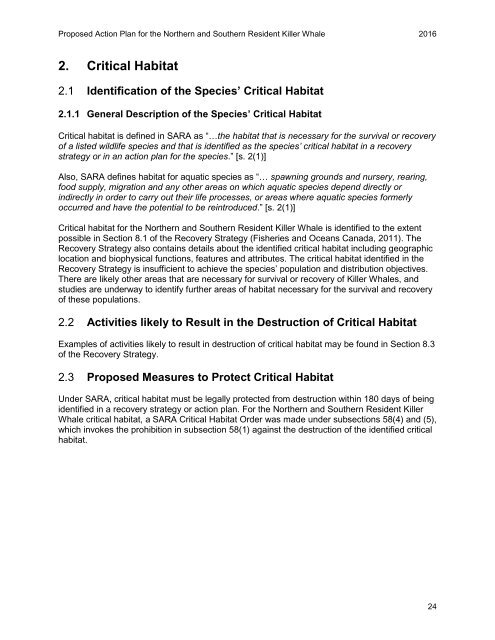Resident Killer Whale
Ap-KillerWhale-v00-2016Jun13-Eng
Ap-KillerWhale-v00-2016Jun13-Eng
You also want an ePaper? Increase the reach of your titles
YUMPU automatically turns print PDFs into web optimized ePapers that Google loves.
Proposed Action Plan for the Northern and Southern <strong>Resident</strong> <strong>Killer</strong> <strong>Whale</strong> 2016<br />
2. Critical Habitat<br />
2.1<br />
2.1.1<br />
Identification of the Species’ Critical Habitat<br />
General Description of the Species’ Critical Habitat<br />
Critical habitat is defined in SARA as “…the habitat that is necessary for the survival or recovery<br />
of a listed wildlife species and that is identified as the species’ critical habitat in a recovery<br />
strategy or in an action plan for the species.” [s. 2(1)]<br />
Also, SARA defines habitat for aquatic species as “… spawning grounds and nursery, rearing,<br />
food supply, migration and any other areas on which aquatic species depend directly or<br />
indirectly in order to carry out their life processes, or areas where aquatic species formerly<br />
occurred and have the potential to be reintroduced.” [s. 2(1)]<br />
Critical habitat for the Northern and Southern <strong>Resident</strong> <strong>Killer</strong> <strong>Whale</strong> is identified to the extent<br />
possible in Section 8.1 of the Recovery Strategy (Fisheries and Oceans Canada, 2011). The<br />
Recovery Strategy also contains details about the identified critical habitat including geographic<br />
location and biophysical functions, features and attributes. The critical habitat identified in the<br />
Recovery Strategy is insufficient to achieve the species’ population and distribution objectives.<br />
There are likely other areas that are necessary for survival or recovery of <strong>Killer</strong> <strong>Whale</strong>s, and<br />
studies are underway to identify further areas of habitat necessary for the survival and recovery<br />
of these populations.<br />
2.2<br />
Activities likely to Result in the Destruction of Critical Habitat<br />
Examples of activities likely to result in destruction of critical habitat may be found in Section 8.3<br />
of the Recovery Strategy.<br />
2.3<br />
Proposed Measures to Protect Critical Habitat<br />
Under SARA, critical habitat must be legally protected from destruction within 180 days of being<br />
identified in a recovery strategy or action plan. For the Northern and Southern <strong>Resident</strong> <strong>Killer</strong><br />
<strong>Whale</strong> critical habitat, a SARA Critical Habitat Order was made under subsections 58(4) and (5),<br />
which invokes the prohibition in subsection 58(1) against the destruction of the identified critical<br />
habitat.<br />
24


